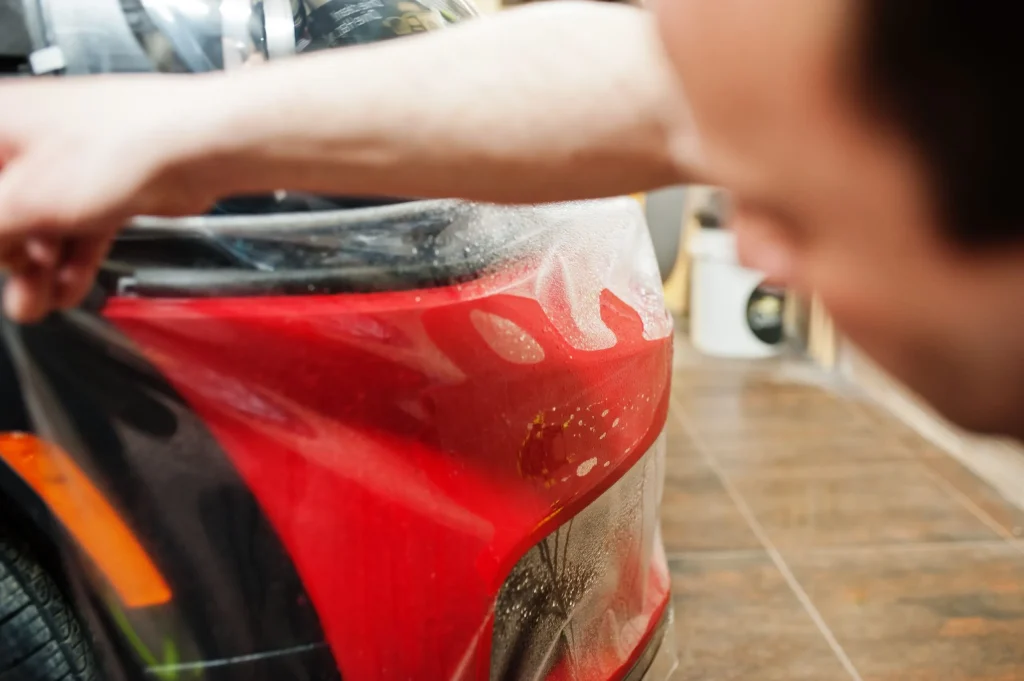Paint Protection Film (PPF) is one of the best investments for keeping your vehicle’s exterior in pristine condition. It acts as a barrier against road debris, scratches, and environmental factors. However, to maximize its benefits, proper maintenance is crucial. A well-maintained PPF not only enhances the vehicle’s appearance but also extends its lifespan. In this guide, we’ll explore the best practices to ensure your PPF remains effective for years.
Understanding Paint Protection Film (PPF)
PPF is a transparent, thermoplastic urethane film applied to a car’s exterior. It protects against scratches, chips, stains, and UV damage while maintaining the original paintwork. Modern PPF options come with self-healing properties, allowing minor scratches to disappear with heat exposure.
Proper maintenance prevents issues like yellowing, peeling, and dirt buildup, ensuring your car looks as good as new for years.
Essential Tips for Maintaining PPF
1. Follow the Curing Process After Installation
After getting a PPF installed, allow it to cure for at least 48 hours before exposing it to moisture. During this time, avoid washing the car or driving in heavy rain to ensure the film adheres properly.
2. Wash Your Car Regularly
Frequent cleaning prevents dirt, dust, and contaminants from accumulating on the film. However, improper washing techniques can cause damage, so follow these best practices:
- Use a pH-balanced car shampoo – Harsh detergents can weaken the adhesive and reduce the film’s longevity.
- Use a microfiber wash mitt – This minimizes the risk of scratches.
- Rinse thoroughly – Any soap residue left behind can cause staining over time.
3. Avoid Automatic Car Washes
While it may be tempting to use an automatic car wash, the rotating brushes can cause micro-abrasions on the PPF. If you must use a car wash, opt for a touchless one that relies on high-pressure water instead of physical brushes.
4. Dry With a Soft Microfiber Cloth
Water spots can leave mineral deposits on the PPF, making the surface look dull over time. To avoid this:
- Use a high-quality microfiber towel to dry the car.
- Avoid using rough cloths or paper towels, as they can scratch the film.
5. Use PPF-Safe Cleaning Products
Some cleaning chemicals contain alcohol, ammonia, or petroleum-based solvents that can degrade the film. When choosing cleaning products:
- Avoid abrasive polishes and waxes that may cause discoloration.
- Opt for PPF-specific cleaners that enhance the film’s clarity and protection.
6. Protect Against Harsh Weather Conditions
Extreme temperatures, UV rays, and environmental contaminants can affect the film’s performance. Here’s how to safeguard it:
- Park in shaded areas or use a car cover to minimize prolonged sun exposure.
- Clean off bird droppings, bug splatter, and tree sap immediately to prevent staining.
- Avoid prolonged exposure to road salt during winter months by washing the vehicle frequently.
7. Apply a PPF-Safe Sealant or Ceramic Coating
While PPF provides excellent protection, adding an extra layer of defense enhances its longevity. A ceramic coating designed for PPF helps by:
- Increasing hydrophobic properties, making it easier to clean.
- Enhancing the film’s resistance to stains and oxidation.
- Providing an additional barrier against UV damage.
8. Inspect the Film Regularly
Regularly check your PPF for signs of lifting, bubbling, or peeling. Early detection of damage allows for quick fixes, preventing more significant issues later. If you notice any problems, consult a professional installer for repairs.
9. Avoid High-Pressure Washing
While pressure washing is effective for cleaning, excessive force can lift the edges of the PPF. If you use a pressure washer:
- Keep the nozzle at least 12 inches away from the surface.
- Avoid directing the spray at the edges of the film.
How Long Does PPF Last?
With proper maintenance, high-quality PPF can last between 5-10 years. Factors like exposure to the sun, driving conditions, and cleaning methods affect its lifespan.
Conclusion
Investing in a Proshield pellicule pare-perre ensures your car remains protected from everyday hazards. However, without proper maintenance, even the best PPF can degrade over time. By following these simple care tips—regular washing, using the right cleaning products, and protecting against extreme conditions—you can keep your PPF looking flawless for years. Not only does this maintain your car’s aesthetics, but it also preserves its resale value.

